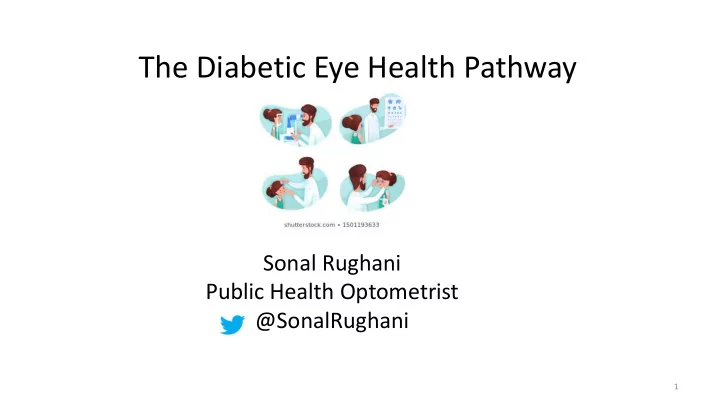

The Diabetic Eye Health Pathway Sonal Rughani Public Health Optometrist @SonalRughani 1
The Different Eye Care Professionals Diabetic Optometrist Retinopathy Screener Rehabilitation Ophthalmologis Integrated Officer t Person-Centred Eye Care Eye Clinic Liaison Orthoptist Officer 2
Types of Eye Checks Eye Examination: every 1-2 years • More than a check for spectacles! • Essential Eye Health Check: all ocular health conditions • Muscle Palsies • Hypertension • Hypercholesterolemia • Glaucoma 3
Eye Examination • Symptoms/No Symptoms • Early Detection • Fluctuating or blurred vision: unstable glycaemic control, unstable refractive status • Glycaemic shifts: cataracts and retinal microvascularisation • Primary Eye Care: pivotal role to play in the early detection and diagnosis of diabetes mellitus. 4
Types of Eye Checks Diabetic Retinopathy Screening Programme: • Annual photographs with a retinal screener every year for everyone with diabetes from age 12. • National Screening Programme: UK only country globally with fully comprehensive screening programme: 5
Diabetic Retinopathy Screening Programme • Introduced in 2003, with roll out in 2007 • Uptake rates: Across England 82.7% in 2017-18. • However, overall uptake rates can mask large variations between certain areas or population groups • Data Sources! 6
Linda’s Story Diabetic Retinopathy Screening https://www.youtube.com/watch?v=uPIb97Oh9g4&feature=yout u.be • Screening does not replace regular eye examinations. • It is important to attend both. 7
Public Health Indicator for Diabetic Eye Disease 8
At Risk Groups • Inequalities & increased risk of progressive visual loss • Lower screening uptake amongst highest risk groups • Socio-economic deprivation • Younger age • Learning Disabilities • Black Asian and Ethnic Minority (BAME) groups. 3x greater in South Asian people compared to Caucasian communities (Pardhan et al, 2004), 9
Symptoms?? Ischaemia and Neovascularisation Cataract/Unstable Sugars Ocular Coherence Tomography Fluoroscein Angiography Diabetic Macular Oedema 10
Secondary Care: Hospital Eye Services • Referral from Optometry: via GP • Urgency: 6 weeks for hospital appointment • Referral from Screening: Monitoring for active retinopathy • Patient Management and Education! • Treatment: Laser Treatment and Anti-VEGF injections 11
Prevention! • Glucose levels • Blood pressure • Health promotion • Prevention • Treatment and rehabilitation strategies, • Feasible, cost-effective of all health care interventions to implement. 12
Modifiable Risk Factors and Prognosis DURATION OF DIABETES • Best predictor of diabetic retinopathy. Diagnosed before age 30 the incidence of DR after 10 years is 50%, after 30 years 90% • Diabetic age 20 years 99% of patients with Type I DM and 60% with type II • 5% of Type II diabetics have DR at presentation.
Modifiable Risk Factors PREGNANCY • Greater pre-pregnancy severity of retinopathy • Poor pre-pregnancy glycaemic control of diabetes. • Rapid control in early stages of pregnancy. • Development of pre-eclampsia and fluid imbalance HYPERTENSION Appropriate Blood-pressure Control in Diabetes (ABCD) Trial: target BP should be <140/80 Tight BP control in type II diabetics with maculopathy NEPHROPATHY 14
Modifiable Risk Factors POOR GLYCAEMIC CONTROL • Increased risk of proliferative disease. • Type I: The Diabetes Control and Complications Trial: intensive control reduced the risk of developing retinopathy by 76% and slowed progression of retinopathy by 54%. • Type II: The UK Prospective Diabetes Study 25% reduction in risk. • Sudden improvement in control may be associated with progression of retinopathy (Chantelau & Kohner). • Target HbA1c level = 6.5-7 % 15
Modifiable Risk Factors SMOKING: 20 a day triples/quadruples retinopathy HYPERLIPIDEMIA OBESITY ANEMIA: leading to hypoxia CARTOID ARTERY OCCLUSIVE DISEASE 16
Expected Vs Reality of vision Post-Laser Treatment The Effects of Laser Treatment • Loss of contrast sensitivity • Loss of Visual Field • Increasing difficulty with steps, curbs • Constriction of visual field 17
Low Vision Assessment • Early intervention: tailored multi-disciplinary assessment • Support with daily living skills • Support with glycaemic control • Medication management • Ingredients 18
Certificate of Vision Impairment • Irreversible vision loss • Timing • Eye Clinic Liaison Officer • Certification and Registration: Bridge to Rehabilitation and Social Care Support • Tiers of Certification: • Sight Impaired (Partially Sighted) • Severely Sight Impaired (Blind) 19
Certificate of Vision Impairment • Irreversible vision loss • Timing • Eye Clinic Liaison Officer • Certification and Registration: Bridge to Rehabilitation and Social Care Support • Tiers of Certification: • Sight Impaired (Partially Sighted) • Severely Sight Impaired (Blind) 20
Diabetic Eye Disease Key Points • Timely Treatment: prevention of irreversible sight loss • Patient Education • Regular follow up, close monitoring • Extent of retinopathy • Collaboration and person-centred care • Success of DESP? 21
Questions 22
Support & Self Advocacy • Local sight loss charity www.visionary.org • RNIB Helpline: 0303 123 9999 www.sightlinedirectory.org.uk • Peer support: rnib connect, connect radio www.rnib.org.uk/connect • Support for people with Learning Disability: www.SeeAbility.org • Guide Dogs : my guide: navigation/befriending www.guidedogs.org.uk 23
Recommend
More recommend